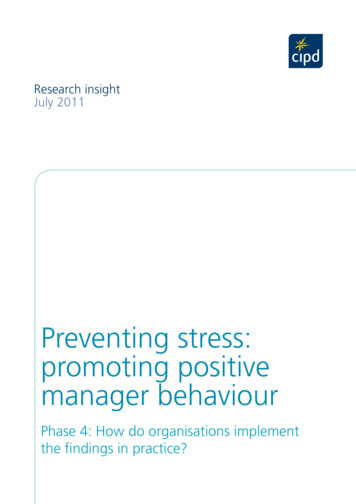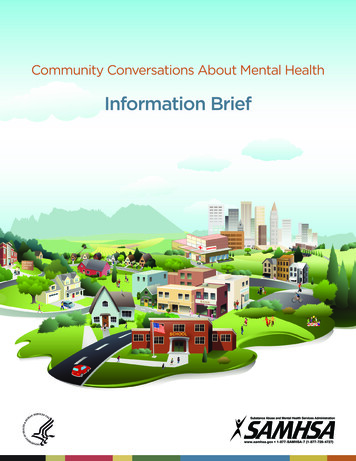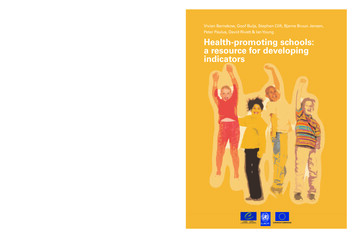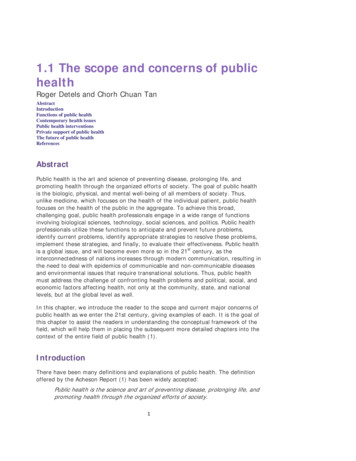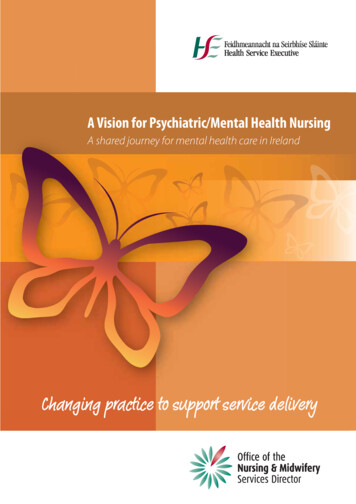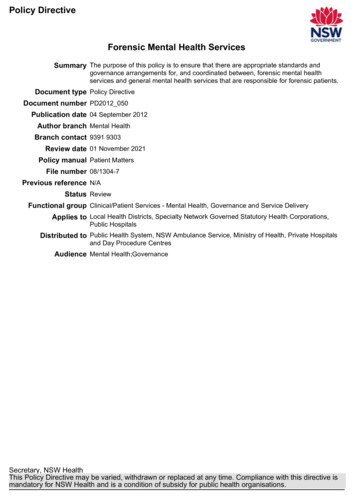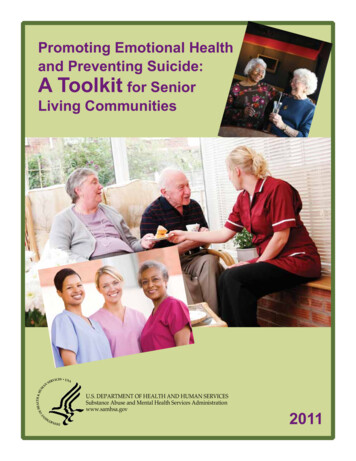
Transcription
ANES USARVICSETHEAL H & HUMPromoting Emotional Healthand Preventing Suicide:A Toolkit for SeniorLiving CommunitiesNTOFU.S. DEPARTMENT OF HEALTH AND HUMAN SERVICESSubstance Abuse and Mental Health Services Administrationwww.samhsa.gov2011DEPARTME
Promoting Emotional Healthand Preventing Suicide:A Toolkit for SeniorLiving Communities2011U.S. Department of Health and Human ServicesSubstance Abuse and Mental Health Services AdministrationCenter for Mental Health Services
AcknowledgmentsThis Toolkit was prepared for the Substance Abuse and Mental Health ServicesAdministration (SAMHSA) by the National Association of State Mental HealthProgram Directors (NASMHPD) in collaboration with Education DevelopmentCenter, Inc. (EDC), McFarland & Associates, Inc., and the National Association ofState Mental Health Program Directors Research Institute, Inc. (NRI) under contractnumber HHSS283200700020I/HHSS2800003T, with SAMHSA, U.S. Department ofHealth and Human Services (HHS). Tarsha M. Wilson, Ph.D., LGSW and RosalynBlogier, LCSW-C served as the Government Project Officers.DisclaimerThe views, opinions, and content of this publication are those of the author and donot necessarily reflect the views, opinions, or policies of SAMHSA or HHS.The people depicted in this toolkit are models only. They are not included to illustrate the mental health issues addressed in this toolkit nor do the authors of thisdocument have any reason to believe that they experienced any of the mentalhealth issues addressed in this toolkit.Public Domain NoticeAll material appearing in this report is in the public domain and may be reproducedor copied without permission from SAMHSA. Citation of the source is appreciated.However, this publication may not be reproduced or distributed for a fee without thespecific, written authorization of the Office of Communications, SAMHSA, HHS.Electronic Access and Copies of PublicationThis publication may be downloaded or ordered at www.samhsa.gov/shin.Or, please call SAMHSA’s Health Information Network at 1-877-SAMHSA-7(1-877-726-4727).Recommended CitationSubstance Abuse and Mental Health Services Administration, Promoting EmotionalHealth and Preventing Suicide: A Toolkit for Senior Living Communities. HHSPublication No. SMA 4515, CMHS-NSPL-0197. Rockville, MD: Center for MentalHealth Services, Substance Abuse and Mental Health Services Administration,2011.Originating OfficeCenter for Mental Health Services, Substance Abuse and Mental Health ServicesAdministration, 1 Choke Cherry Road, Rockville, MD 20857 HHS Publication No.SMA 4515, CMHS-NSPL-0197. Printed 2011.Toolkit Overviewiv
Toolkit OverviewThis Toolkit, Promoting Emotional Health and Preventing Suicide: A Toolkit forSenior Living Communities, contains resources to help staff in senior living communities promote emotional health and prevent suicide among their residents. Seniorliving communities include nursing homes, assisted living facilities, independent living facilities, and continuing care retirement communities. The Toolkit uses a comprehensive framework made up of three essential approaches (Langford, 2008): Whole Population Approach: Activities and programs that benefit the emotional well-being of all residents At-Risk Approach: Strategies ensuring that staff properly identify and effectively treat residents at risk of suicide Crisis Response Approach: Procedures for appropriate responses to suicide deaths and attemptsThe Toolkit also provides resources and information to help residents become active participants in emotional health promotion and suicide prevention efforts.Older adults die by suicide at a higher rate than the national average. Rates go upafter age 65, primarily among white men (CDC, 2006). When older adults attemptsuicide, they are more likely to die: 1 out of every 4 older adults who attempt suicide dies, compared to 1 out of every 100–200 younger adults who attempt suicide(American Association of Suicidology, 2009). There are few reliable statistics onsuicide in senior living communities. However, we do know that residents of thesecommunities have many of the risk factors associated with suicide, such as depression, social isolation, lack of a sense of purpose in life, illness and pain, and familylosses.This Toolkit will show you that senior living communities have many opportunities toprevent suicide and other self-destructive behaviors without having to create newprograms or hire new staff. It provides guidelines for integrating suicide preventioninto your ongoing programs and procedures, as well as hands-on tools, trainingmanuals, and many examples from your colleagues around the country.Toolkit Overviewv
Why should you use the Toolkit?When we visited senior living communities to develop this Toolkit, the staff at onefacility shared with us the reasons why they were interested in learning more aboutthe topic of suicide. The most dramatic reason was the following story. The nameshave been changed, but the story is true.Mr. and Mrs. Johnson moved into the Maple Tree Assisted Living Center, located inone of the New England states. Mr. Johnson was pleased with the move, but according to staff, his wife came in “kicking and screaming.” Although Mr. Johnson ate in thedining room and began participating in the activities offered to the residents, his wifewould not. She took all her meals in her room. In fact, she stayed in her room most ofthe time. Her husband told the staff he was worried but didn’t know what to do. Thestaff reassured him she would eventually settle in—but she didn’t.One day Mr. Johnson returned from lunch to find his wife lying on the floor. She hadcut her wrist with a knife. She was rushed to the hospital.Mrs. Johnson survived and received inpatient treatment in the hospital for one month.The event was terribly traumatic for both Mr. and Mrs. Johnson, as well as for the staffand the other residents at Maple Tree. The staff spent a lot of time wondering what theycould have done to prevent that event.Mrs. Johnson returned to Maple Tree when her doctor felt she would be safe. Her family started visiting more often. The activities director convinced her to join a book cluband to volunteer to welcome new residents. She also agreed to join a life review therapygroup facilitated by the social worker. The nursing assistants and housekeepers madea point of chatting with the Johnsons when they visited their apartment. And, Mrs.Johnson started eating in the dining room.Today, seven years later, the staff says, “You’d never suspect that Mrs. Johnson is the personwho tried to take her life. She misses her husband, who died two years ago. But at 93 yearsold, she is one of the most well-liked, engaged, and outgoing residents in Maple Center!”Fortunately, the story had a happy ending. But if Mr. Johnson had decided to reada newspaper after lunch or had stopped for a conversation before checking on hiswife, she could have bled to death.We do not know how many residents of senior living communities attempt suicide ordie by suicide. But, we do know that a suicide in a facility such as yours profoundlyimpacts the lives of everyone concerned—residents, families, and staff. And we alsoknow there are ways that we—and you—can reduce the risk of suicide. It is our hopethat this Toolkit will help prevent your facility from having its own Mrs. Johnson story.Toolkit Overviewvi
Who is the Toolkit for?The Toolkit has resources relevant to any type of senior living community, includingnursing homes, assisted living facilities, independent living facilities, and continuing care retirement communities. There is information targeted to professional andparaprofessional staff in all departments, including the executive director, administrators, department managers, and supervisors; nursing, medical, mental health,and social work staff; clergy; activities and wellness staff; and dietary, housekeeping, transportation, maintenance, grounds, and security staff. While everyone in asenior living community has a role to play in promoting emotional health and preventing suicide, each component of the Toolkit has a specific target audience. Theaudience for each component is detailed in the list of Toolkit contents below.Terms Used in This ToolkitSenior living communities use a variety of terms for certain staff roles. The followingexplains the terms used in this Toolkit. Nursing assistants includes certified nurse aides, nurse aides, geriatric nurse aides,personal care assistants, or direct care workers, depending on the state and the facility Activities and wellness staff includes recreation, fitness, and health promotion Dietary staff includes everyone involved in planning, preparing, and serving foodWhat Is a Senior Living Community?We define senior living community as a residential facility for older adults. There aremany names for these facilities. The differences between the categories below have todo with the overall types of services and levels of care provided. The following are themain categories targeted by this Toolkit, followed by some of the names used for facilities within each category: Independent living: retirement communities, independent living residences,senior apartments, senior housing Assisted living: personal care homes, board and care homes, rest homes, congregatehousing, residential care facilities, domiciliary care (a name common among VeteransAdministration residential facilities for older adults), supported care, adult foster care,adult care homes, adult family homes, sheltered housing, community residences Nursing homes: skilled nursing facilities, long-term care facilities Continuing care retirement communities: life-care facilities, life-carecommunitiesToolkit Overviewvii
What is in the Toolkit?The following list identifies each of the Toolkit components, indicates the primaryaudience, and summarizes the contents:MES USARVICSETHEAL H & HUANOFU.S. DEPARTMENT OF HEALTH AND HUMAN SERVICESSubstance Abuse and Mental Health Services Administrationwww.samhsa.govT It summarizes the Toolkit and provides information intendedto motivate senior staff to use the Toolkit to strengthen theiremotional health promotion/suicide prevention efforts.N This document is targeted to the administrators and seniormanagers of the senior living community.Promoting Emotional Healthand Preventing Suicide:A Toolkit for SeniorLiving CommunitiesDEPARTME1. Toolkit Overview2. A Guide to Promoting Emotional Health and Preventing Suicide inSenior Living Communities This document is targeted to administrators and senior managers, but it contains information on the roles of all staff inthe facility.A Guideto Promoting EmotionalHealth and PreventingSuicide in Senior LivingCommunitiesANES USARVICSETHEAL H & HUMContents: Getting Started Goals and Action Steps Tools for Implementing Action StepsNTOFU.S. DEPARTMENT OF HEALTH AND HUMAN SERVICESSubstance Abuse and Mental Health Services Administrationwww.samhsa.gov2011 The Guide has a chapter dedicated to each approach inthe Framework: Whole Population; At Risk; and CrisisResponse. Each chapter has background information, goalsrelevant to the three approaches, and action steps your staffcan take to meet those goals.DEPARTME The Tools for Implementing Action Steps section of the Guide contains a variety of worksheets, fact sheets, and program descriptions to help you createand implement many of the action steps.3. Trainer’s Manual The Trainer’s Manual is designed to be used by theperson(s) who provides education to your staff and residents and their families.Trainer’s Manualfor Promoting EmotionalHealth and PreventingSuicide in Senior LivingCommunities The Trainer’s Manual includes materials for conductingthree one-hour workshops: two workshops for staff and oneworkshop for families and residents. The staff workshopsare intended to reinforce background information providedin the Guide and to help staff implement some of the key steps it recommends. The workshop for families and residents is intended to provide somekey information from the Guide and to encourage residents to take advantage of the activities and programs the facility is implementing as part of itsapproach to emotional health promotion and suicide prevention.ANES USARVICSETHEAL H & HUMContents: Staff Workshop 1 Staff Workshop 2 Family and Resident WorkshopNTOFU.S. DEPARTMENT OF HEALTH AND HUMAN SERVICESSubstance Abuse and Mental Health Services Administrationwww.samhsa.govDEPARTMEToolkit Overviewviii2011
4. Fact Sheets for ResidentsFact Sheets for Residents:Look Out for the Well-Being of Yourself and OthersKnow the Warning Signs of SuicideAfter a Suicide: How to Help Yourself and Others These fact sheets are targeted to your residents. They mayalso be useful for family members and your staff. The factsheets should be distributed to residents with staff guidance as part of a workshop, one-on-one session, or groupmeeting.2011Instructions for Using the Fact Sheets for ResidentsThe Fact Sheets for Residents provide senior living community residents and their familieswith useful information on three topics: maintaining emotional health, preventing suicide,and coping with suicide. They are intended to be given to residents by staff or other mentalhealth professionals. Since they cover emotionally sensitive topics, these sheets should begiven to residents only in settings in which they can be discussed. A staff person can helpexplain the information, answer questions, and help residents deal with any feelings thatmay come up.The following provides suggested settings in which the fact sheets can be distributed anddiscussed: Looking Out for the Well-Being of Yourself and Others: Family and Resident Workshop Health promotion or wellness programs Know the Warning Signs of Suicide: Family and Resident Workshop Support group run by a social worker or other mental health professional Individual sessions with a social worker or other mental health professional After a Suicide: How to Help Yourself and Others: Community meetings, as described in the Guide, Tool 3.f: Community SupportMeetings for Senior Living Communities Support group run by a social worker or other mental health professional Individual sessions with a social worker or other mental health professionalThe fact sheets may also be useful handouts for participants in the staff workshops. Thesheets provide staff with the key information and wording to use in discussing issues relatedto emotional health and suicide with residents.At the end of each fact sheet is space to fill in the names of relevant contact people fromwhom residents (or staff) can seek help. At least one person should be in your senior livingcommunity, such as a social worker or other mental health professional. Also list a contactperson in a local agency, such as a community mental health center. Please be sure thisinformation is on the fact sheets when you give them to residents (or staff). The three fact sheets contain information on the roles ofresidents in each of the three approaches to emotionalhealth promotion and suicide prevention in senior living communities: Look Out for the Well-Being of Yourself and Others Know the Warning Signs of Suicide After a Suicide: How to Help Yourself and OthersToolkit Overviewix
How do you use the Toolkit?1. Share the Cover Letter and Toolkit with your managers Provide these items to your key managers. Encourage them to read this Toolkit Overview before you meet.2. Start with the Guide Meet with your key managers and spend a few minutes discussing theSample Policy and the Facility Assessment Checklist in the Guide. Youwill probably identify a number of needs that you can meet by taking somesimple actions. Taking these actions will help you promote emotional healthand prevent suicide in your senior living community. Ask your key managers to go through the Guide and select those actionsteps they think are most feasible and will help address some needs highlighted in the Facility Assessment Checklist. Convene relevant staff to make a plan to implement the action steps. Youwill probably include at least the staff from nursing, social work, activities andwellness, and facilities. Use the many tools provided in the Guide.3. Offer the Workshops Ask the person responsible for delivering staff training to schedule times tooffer the two staff workshops in the Toolkit. These workshops will help reinforce the information in the Guide and will provide the opportunity to beginplanning to take some of the recommended action steps. Ask the person responsible for family outreach to schedule a time to deliverthe workshop for families and residents. You might also consider offering thisto the community at large.4. Distribute the Fact Sheets for Residents in a Number of Ways: During the Family and Resident Workshop as part of health promotion activities, through your health care staff, in support groups, or in other ways thatseem appropriate for your facility.Toolkit Overviewx
Appendix A: Contributors to the ToolkitThe following people contributed their expertise and time to the development of this Toolkit:SPARK staff NASMHPD: Robert Glover, Lauren Kamnik, Christy Lentz EDC: Jerry Reed, Christine Miara, Laurie Rosenblum, Elizabeth Frisco, Jeannette Hudson,Marc Posner, Nancy Davis, Jennifer Smith McFarland & Associates, Inc.: Barbara Milton-King, Sylvia Joice, June Murray NRI: Noel Mazade, Jeanne Rivard, Michael LaneExternal Workgroup members Leona Bachrach, Asbury Methodist Village, Gaithersburg, MD David Denton, Asbury Methodist Village, Gaithersburg, MD Ruth Kent, Ingleside at Rock Creek, Washington, DC Amy Ostrolenk, Asbury Methodist Village, Gaithersburg, MD Eve Byrd, Fuqua Center for Late-Life Depression, Atlanta, GA Patrick Cook, Macro International, Inc., Rockville, MD Gary Kennedy, Montefiore Medical Center, New York, NY; American Association of GeriatricPsychiatry; Geriatric Mental Health Foundation Richard McKeon, Substance Abuse and Mental Health Services Administration, Rockville, MD Alixe McNeill, National Council on Aging, Washington, DC Linda Langford, Education Development Center, Inc., Newton, MA Nancy Osgood, Virginia Commonwealth University, Richmond, VA Lisa Pape, Veterans Administration, Washington, DC Jane Pearson, National Institute of Mental Health, Bethesda, MD Carol Podgorski, University of Rochester, Rochester, NY Dorothea Rogers, Cardinal Ritter Senior Center, St. Louis, MOInput and review of all documents, and help with piloting the workshops, were provided bystaff at the following: Federal agencies: Central and regional offices of the Administration on Aging, NationalInstitute of Mental Health, Veterans Administration Organizations: Suicide Prevention Resource Center, American Association for Homes andServices for the Aging, CrisisLink, National Council on Aging, NASMHPD Older PersonsDivision Senior Living Communities: Asbury Methodist Village, MD; Assisted Living Concepts, WI;Brethren Care Village, OH; Capitol Ridge, RI; Chelsea Senior Living, NJ; Christian HealthCare Center, NJ; Evans Park, MA; Hearthstone Retirement Community, WA; LexingtonHealth Care Center, MA; North Hill, MA; Waltham Crossings, MAReferencesAmerican Association of Suicidology. (2009). U.S.A. suicide: 2006 official final data. Retrieved May14, 2009, from ls/statisticsCenters for Disease Control and Prevention (CDC). (2006). WISQARS fatal injuries: Mortality reports. National Center for Injury Prevention and Control, CDC. Available at angford, L. (2008, October). Framework for mental health promotion and suicide prevention in senior living communities. Suicide Prevention Resource Center. Working draft for the meeting “It takesa community: A summit on opportunities for mental health promotion and suicide prevention effortsin senior living communities,” Gaithersburg, MD.Toolkit Overviewxi
HHS Publication No. SMA 4515, CMHS-NSPL-0197.Printed 2011
Senior Living Communities, contains resources to help staff in senior living commu-nities promote emotional health and prevent suicide among their residents. Senior living communities include nursing homes, assisted living facilities, independent liv-ing facilities, and contin

